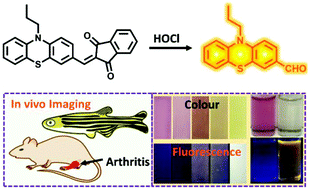A highly specific fluorescent probe for rapid detection of hypochlorous acid in vivo and in water samples†
Abstract
Hypochlorous acid (HOCl) is closely related to human health and is widely used in our daily lives. Accordingly, detection of HOCl in live organisms and natural water samples is significantly important to human and animal health. In this paper, a novel chromogenic and fluorogenic probe (PI) was prepared for HOCl detection with high sensitivity and specificity. PI exhibits weak fluorescence emission owing to the intramolecular charge transfer (ICT) process from the carbazole to indandione unit. The oxidative cleavage of the alkene unit of PI induces the interruption of its π-conjugation, resulting in colorimetric and fluorogenic responses towards HOCl in PBS buffer. The detection limit of PI for HOCl was calculated to be as low as 24 nM. The fluorescence response of PI towards HOCl was found to be completed within 1 minute. PI exhibits high selectivity towards HOCl and low cytotoxicity, which allows it to be used as a fluorescent imaging probe for visualisation of exogenous and endogenous HOCl in live adult zebrafish and nude mice. Moreover, “naked-eye” analysis of the HOCl concentration in several natural water samples has been realized using PI-based test plates.



 Please wait while we load your content...
Please wait while we load your content...